#bushoong
Explore tagged Tumblr posts
Text

n'tchak
96 notes
·
View notes
Text
“The more august the individual, the more ornate the apparel, right up to the official and ritual clothing of the Bushoong Kings.”
African Costumes and Textiles: From the Berber to the Zulus
0 notes
Video
youtube
Bushoong - War Pigs
7 notes
·
View notes
Photo

Ngady Mwaash Mask, 20th century, Minneapolis Institute of Art: Art of Africa and the Americas
small face with wide slit eyes; face decorated with white, tan and brown lines and triangles; cloth band with shells down center of face; blue and red cloth at top of head decorated with shells and beads The Bushoong believe that in order to achieve balance in life, it is important to connect with their ancestors. The spirit world acts as an intermediary to the ancestors by communicating important guidance to the living. Like many cultures, death is a natural event in the life cycle, and is seen as a transition rather than an end. For the Bushoong, funerals are extremely important ceremonies because although it is a time for mourning, it is also a time for celebrating the person's transition into the afterlife. Typically, the Bushoong perform a masquerade that honors tradition and heritage during funeral ceremonies. It is through their performance that the masked dancers reenact their origin story. The Ngady Mwaash mask shown here, personifies the wife of the ancestral king Woot who is represented by the mask Mwaash Mbooy. The two of them share their history with the observers as they tell the story of how they came to lead their people. Size: 16 x 6-7/8 x 6-7/16 in. (40.6 x 17.5 x 16.4 cm) Medium: Wood, cloth, cowrie shells, beads, pigment, plant fibers
https://collections.artsmia.org/art/55218/
9 notes
·
View notes
Photo



Kuba skirts, Tcaka, are cloths made from raffia, from 8 - 25 feet long, from the Ngeende, Bushoong and Ngongo peoples. They incorporate appliqued "patches", embroidered shapes and patterns, openwork, tie-dye, cowrie shells, barkcloth and border elements. The appliqued "patches" originally repaired holes, then developed into traditional design motifs. .Most are covered with geometric symbols; many are restrained, subtle and rhythmic designs using one technique; others create amazing quilt-like assemblages of old pieces of many forms. The full skirts, worn by men and women, are bunched up and wrapped around many times. Hamill Gallery.
3 notes
·
View notes
Photo

Join us as we take you on a tour of African Arts—Global Conversations. Curated by Kristen Windmuller-Luna and presented by Bank of America.
African Arts—Global Conversations puts African arts where they rightfully belong: within the global art historical canon. This exhibition pairs diverse African works with objects from around the world in groupings throughout the Museum.
These groupings explore how shared themes such as portraiture, faith, modernism, and origins developed independently in different parts of the globe and fill in the blanks of decades of art history teaching.

Beginning in our introductory gallery, two idealized portraits of African rulers made centuries apart greet visitors.
These portraits respect cultural norms about how a ruler is expected to look, often combining distinctive individual features with visual concepts such as divinity or rulership.

Kuba artist (Bushoong clan). Ndop figure depicting Nyim Mbó Mbóosh (reigned circa 1650), Nyim Mishé miShyááng máMbúl (reigned circa 1710), or Nyim Kot áNée (reigned circa 1740), circa 1760–80. Mushenge (Nsheng), Kasai Province, Democratic Republic of the Congo. Wood, tukula, 19 1/2 x 7 5/8 x 8 5/8 in. (49.5 x 19.4 x 21.9 cm). Purchased with funds given by Mr. and Mrs. Alastair B. Martin, Mrs. Donald M. Oenslager, Mr. and Mrs. Robert E. Blum, and the Mrs. Florence A. Blum Fund, 61.33.
Kuba ndop (commissioned royal portraits) represent the concept of leadership and contain a ruler’s life essence.The hand on this drum identifies this ruler as one of three Kuba nyim (kings): Mbó Mbóosh, Mishé miShyááng máMbúl, and Kot áNée.
Other royal indicators include his long-brimmed headdress, cowrie belt and armbands, and calm expression.

Egyptian artist. Ptolemaic Prince, 51–30 B.C.E. Egypt. Quartzite, 12 1/2 x 5 5/16 x 3 3/8 in. (31.8 x 13.5 x 8.5 cm). Charles Edwin Wilbour Fund, 54.117.
Ancient Egyptian sculptures use hieroglyphic text to identify subjects by name, but a blank back pillar suggests this sculpture is unfinished.
Although this figure is unidentified, his youth, crown, and Hellenistic hair and face suggest that he is Caesarion, son of Cleopatra VII and Julius Caesar.

Warriors hold a valued place in many societies across time and place. Warriors’ memorials reflect what societies think these figures “should” look like, often representing ideals rather than individuals.

Huastec artist. Warrior Figure, circa 1440–1521. Xico Viejo, Veracruz, Mexico. Sandstone, 65 3/16 x 14 3/4 x 7 1/2 in. (165.6 x 37.5 x 19.1 cm). Frank L. Babbott Fund, 39.371.
Wooden stelae (left/middle) memorializing powerful Konso warriors in Ethiopia were grouped with additional sculptures of weapons, slain animals, and defeated foes. The stelae memorialize specific male Konso ancestors, emphasizing his individual deeds as well as his connection to shared experiences and values.
The stone Huastec warrior figure (right) from Mexico is adorned with fearsome symbols of death such as the human skulls on his skirt and bead-and-human-heart necklace. Huastec viewers who saw these elements knew he was likely Micoatl-Camaxtle, the god of hunting and warfare.

Nestled amongst our European paintings and sculpture collection are three Ethiopian processional crosses.
Beginning in the medieval period, the Christian Ethiopian Kingdom and numerous Italian states enjoyed a lively relationship that included travel and exchange of religious art and ideas between the two regions.
Ethiopian Orthodox priests carried these copper alloy crosses atop staffs (right).
just as their Italian Catholic counterparts carried wooden ones like this (left).
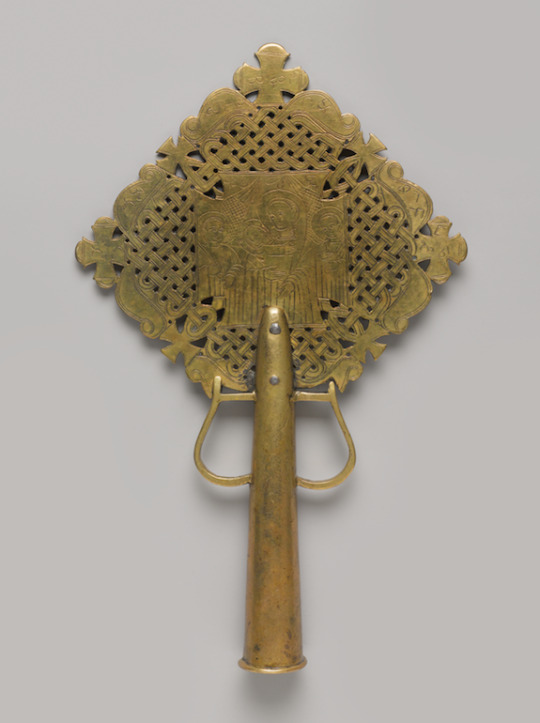
Amhara artist. Processional Cross (qäqwami mäsqäl), late 15th or early 16th century. Possibly Lalibela, Ethiopia. Copper alloy, 11 1/2 x 7 3/16 in. (29.0 x 18.3 cm). Gift of George V. Corinaldi, Jr., 81.163.2.
An Ethiopian artist incised Mary holding the Christ child, archangels, and saints on this fifteenth- or sixteenth century cross.
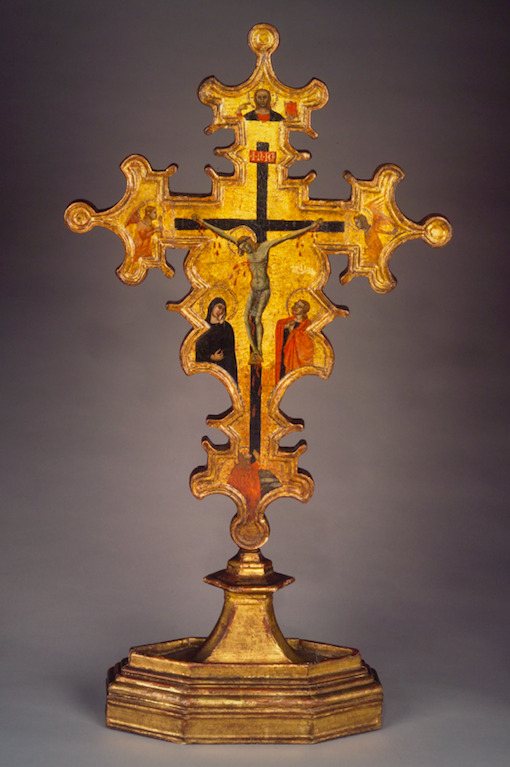
Master of Monte del Lago (Italian, School of Umbria, second quarter of the 14th century). Double-Sided Processional Cross, second quarter of the 14th century. Umbria, Italy. Tempera and gold on panel, 39 1/16 x 16 9/16 x 4 5/8 in. (99.2 x 42.1 x 11.7 cm). Gift of Mary Babbott Ladd, Lydia Babbott Stokes, and Frank L. Babbott, Jr., in memory of their father, Frank L. Babbott, 34.845.
While the Master of Monte del Lago painted Crucifixion scenes on this fourteenth-century gilded Italian cross.
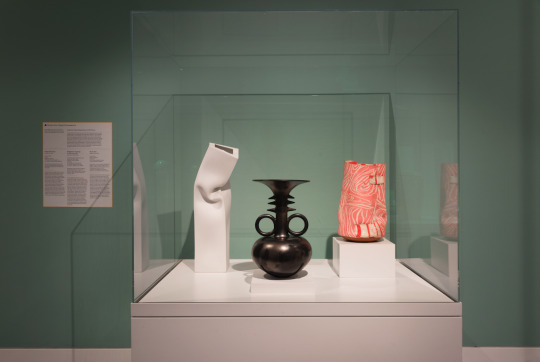
A trio of ceramics made by living artists born in Kenya, Korea, and Nigeria shows the ways that modern ceramicists can choose to draw inspiration from their own regional heritage, or not.
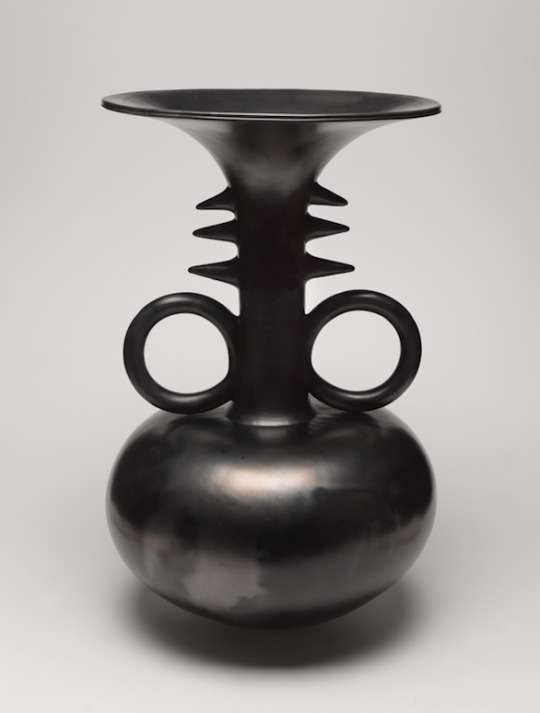
Magdalene Anyango N. Odundo DBE (British, born 1950, Kenya). Symmetrical Reduced Black Narrow-Necked Tall Piece, 1990. Farnham, Surrey, England. Terracotta, 16 x 10 x 10 in. (40.6 x 25.4 x 25.4 cm). Purchased with funds given by Dr. and Mrs. Sidney Clyman and the Frank L. Babbott Fund, 1991.26. © Magdalene Anyango N. Odundo
Dame Magdalene Anyango N. Odundo fires her dramatic pots multiple times to create glossy, iridescent surfaces.
Born in Kenya, she learned ceramics in Britain (where she lives today), citing pottery traditions from multiple other countries as her primary influences, drawing ideas from Nigerian Gwari ceramics, Native American Pueblo pottery, European Modernism, and even ancient Cycladic art.
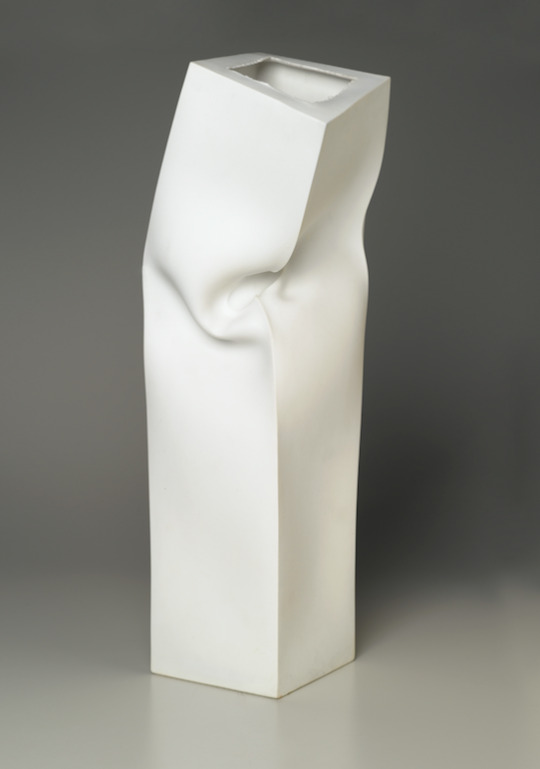
Kang Suk Young (Korean, born 1949). Untitled, 1992. Korea. Unglazed porcelain, 24 13/16 x 6 x 6 in. (63 x 15.3 x 15.3 cm). Purchased with funds given by Dr. and Mrs. Richard Dickes, 2006.20. © Kang Suk Young
Kang Suk Young uses porcelain, a medium that is traditional in his home country of Korea, but he creates forms using slip casting, a method he learned in France. He pulls the porcelain from its mold when it is still somewhat soft and twists and bends it to create something that is lively and anthropomorphic.

Ranti Bam (Nigerian, born 1982). Antafi, 2019. London, England. Terracotta, 15 3/8 × 8 1/4 × 8 1/4 in. (39 × 21 × 21 cm). Gift of Anne Goldrach in honor of Anne Pasternak, 2019.25. © Ranti Bam
Ranti Bam has created a very complex object, contrasting a heavy clay slab with delicate painting, and a rough surface with areas of shiny glaze.
The painted surface references woodgrain, but in an unlikely color of dark pink that gives the vessel its name, Antafi, a word that the artist derived from the Greek word for “rose” (triantafyllo).

Although these artists participate in the multinational field of contemporary ceramics, their work has until now been categorized by the museum according to their place of birth.
Grouping these ceramics highlights how museums (including Brooklyn!) tend to leave artists born outside of Europe and the U.S. out of conversations about contemporary art.

Kongo (Yombe subgroup) artist. Power Figure (nkisi): Woman and Child, 19th century. Lower Congo Province, Democratic Republic of the Congo. Wood, glass, upholstery studs, metal, metal and glass buttons, resin, 11 x 5 x 4 1/2 in. (27.9 x 12.7 x 11.4 cm). Museum Expedition 1922, Robert B. Woodward Memorial Fund, 22.1138.
This sculpture is linked to a Kongo fertility-focused women’s cult that flourished during the height of the Transatlantic Slave Trade. During this period, women both raised children and took on customarily male agricultural roles. Made into an nkisi (power figure), it underscores how Kongo women supported future generations during a time of widespread social upheaval and trauma.

Louis Rémy Mignot (American, 1831-1870). Niagara, 1866. Oil on canvas, 61 1/2 × 104 1/4 × 4 1/2 in. (156.2 × 264.8 × 11.4 cm). Gift of Arthur S. Fairchild, 1993.118.
Displayed in a gallery devoted to Civil War and Reconstruction-era (1861–1877) American art, this sculpture provides a poignant Central African perspective on the widespread repercussions of the Transatlantic Slave Trade.
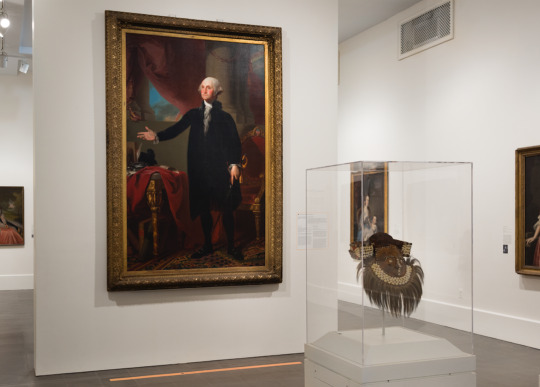
On the fifth floor, you’ll find a pairing of two great leaders: Wóót and George Washington. Artist-made images created before the invention of photography, they show how two artists represented their society’s founding fathers.

Kuba artist. Mask (Mwaash aMbooy), late 19th or early 20th century. Kasaï Province (former Kasaï-Occidental Province), Democratic Republic of the Congo. Rawhide, paint, plant fibers, textile, cowrie shells, glass, wood, monkey pelt, and feathers, 22 x 20 x 18 in. (55.9 x 50.8 x 45.7 cm). Museum Expedition 1922, Robert B. Woodward Memorial Fund, 22.1582.
The Mwaash aMbooy mask personifies Wóót, mythical ancestor of the D.R. Congo’s Kuba peoples. Kings performed this mask during initiations and funerals. One performance tells the story of Wóót’s role in the Kuba kingdom's founding and his ties to its first ruler.

Gilbert Stuart (American, 1755–1828). George Washington, 1796. Oil on canvas, 96 1/4 x 60 1/4 in. (244.5 x 153 cm). Dick S. Ramsay Fund and Museum Purchase Fund, 45.179.
Gilbert Stuart’s larger-than-lifesize portrait of George Washington reminds a young republic of the soldier who led them to victory and the statesman who stepped down from power for the country to flourish for some.
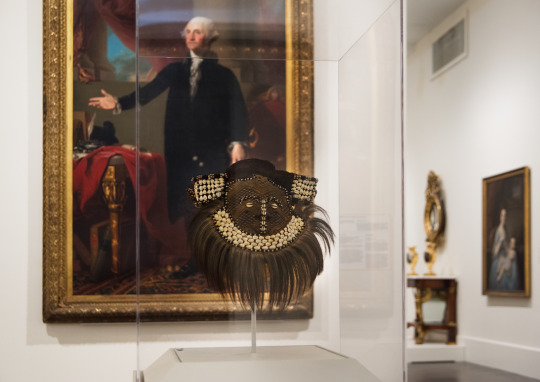
Both works rely on extensive symbolism and create enduring images of “founding fathers.”
While Stuart’s portrait turned an individual into an icon, the Kuba artist’s Wóót mask connected a current ruler to his dynastic past.

Beauford Delaney began including African artworks in a series of compositions from the 1940s as he deepened his engagement with the African American cultural movement called the Harlem Renaissance.

Beauford Delaney (American, 1901-1979). Untitled (Fang Sculpture, Crow and Fruit), 1945. Oil on canvas, 25 x 30 in. (63.5 x 76.2 cm). Brooklyn Museum, Brooklyn Museum Fund for African American Art in honor of Arnold Lehman, A. Augustus Healy Fund and Ella C. Woodward Memorial Fund, 2014.73. © artist or artist's estate (Photo: Brooklyn Museum, 2014.73_PS9.jpg)
In this dynamic and brightly colored still life, a bird of spirit figure hovers over a bowl of lemons, presenting them as an offering to Fang ancestors represented by the reliquary sculpture seen at right.

An Ntem River Valley Master. Reliquary Guardian Figure (Eyema-o-Byeri), mid-18th to mid-19th century. Wood, iron, 23 × 5 3/4 × 5 in. (58.4 × 14.6 × 12.7 cm). Brooklyn Museum, Frank L. Babbott Fund, 51.3. Creative Commons-BY (Photo: , 51.3_overall_PS9.jpg)
By showing this painting alongside its specific source and acknowledging the contributions of Fang master artists, this grouping brings to life a transatlantic cultural dialogue and exchange.

This is just a small glimpse of the works on view in this groundbreaking exhibition.��Come see for yourself as soon as we reopen our galleries!

Thank you for joining us on our tour of African Arts—Global Conversations. Join us next Sunday for another tour of our galleries!
Installation views of African Arts—Global Conversations by Jonathon Dorado.
#Virtual tour#virtual#virtual programming#Brooklyn#Brooklyn Museum#arthistory#bkmafricanarts#global conversations#african art
83 notes
·
View notes
Photo

Belt of the Bushoong group of the Kuba people, 1900s, Democratic Republic of the Congo.
7 notes
·
View notes
Photo


“out of africa”
congo - tissus kuba -
peinture inspirée par les tissus
longs pagnes à « motifs appliqués » raphia du kasaï
réalisés par les artistes Kuba-Bushoong
(République Démocratique du Congo, région du Kasaï).
———————————————————————————————-
réalisation jonas - janvier 2019
acrylique sur toile - 30F 92x73
certificat unique et facturation
500€ le tableau
-----------------------------------------------------------------------------------
possibilité de prêt (association,collectivité à but non lucratif)
possibilité de location : semaine,mois,année (autres structures)
------------------------------------------------------------------------------------
pour tout contatct :
4 notes
·
View notes
Text





Kuba masks are famous for their rich cowrie and pearl decorations. There are many regional stylistic interpretations of the Bwoom mask but the most prominent features of the mask are invariably its bulging forehead and wide nose. This specimen is distinguished by its anthropomorphic forms. More than twenty types of masks are used among Kuba, with meanings and functions that vary from one group to another. Three types of masks have been associated with dances that take place in the royal enclosure: the first, called Moshambwooy, represents Woot, the founder of the Bushoong, the hero of the culture. The second, known as Nady Amwaash (Ngaady A Mwash), embodies the wife / sister of Woot, a character who was introduced to the pageantry to give more importance to the role of women. The third mask is called Bwoom. As a character, Bwoom has been interpreted variously as a prince (younger brother of the king), a man of the people, a pygmy, even a subversive element in the royal court.
Kuba Race
DRC country
Materials Wood, raffia, brass, cowries, pearls
Height 26
width 18
Weight 0,77 Kg
Estimated date circa 1965
Base included Optional
800.00€
1 note
·
View note
Text
Today in Christian History

Today is Monday, May 14, the 134th day of 2018. There are 231 days left in the year.
Today’s Highlight in History:
1610: Assassination at Paris of Henry IV of France, formerly a Huguenot, who had converted to Catholicism to become king.
1692: Sir William Phipps arrives in Massachusetts with a new charter that ends theocratic rule in the British colony.
1759: In Everton, England, Anglican evangelical John Berridge preaches outdoors for the first time. His message is one of salvation by grace alone: “Cease from thine own works.”
1826: Baptism of Nathanael Tajkhan, formerly a Muslim, then a Hindu, until he heard the word of God. He became a zealous convert, preaching wherever he had opportunity, although renounced by his village. He won his wife and some others to Christ before his untimely death.
1846: During the construction of a new cathedral at Zadonsk, remains of Tikhon, the Russian Orthodox bishop of Veronezh, are uncovered incorrupt. Many miracles will be reported occurring near them and he will be named a saint. He had written spiritual works stressing love and forgiveness.
1858: Death of Bennet Tyler, a Congregational theologian who had served as president of Dartmouth College and was a founder of the Theological Institute of Connecticut (now Hartford Seminary). While he was president of Dartmouth, the college admitted its first African-American student.
1901: Althea Brown, an African-American Christian, is commissioned to go to Africa as a missionary. She will die there of malaria and sleeping sickness after compiling a dictionary and grammar of the Bushoong tribal language.
1941: Christian missionary/educator Minnie Vautrin gasses herself to death, unable to cope with memories of wartime experiences in which she protected thousands of Chinese women from rape by Japanese invaders.
1948: Defying the advice of his State and War Departments, President Harry Truman issues a de facto recognition of the State of Israel within hours of its declaration of independence.
8 notes
·
View notes
Photo

▪Mwaash aMbooy Mask. Culture: Kuba (Bushoong subgroup) Place of origin: West Kasai Province Date: late 19th or early 20th century Medium: Hide, paint, plant fibers, textile, shell, glass, wood, hair, feathers.
16 notes
·
View notes
Photo

Ngady Mwaash Mask, 20th century, Minneapolis Institute of Art: Art of Africa and the Americas
small face with wide slit eyes; face decorated with white, tan and brown lines and triangles; cloth band with shells down center of face; blue and red cloth at top of head decorated with shells and beads The Bushoong believe that in order to achieve balance in life, it is important to connect with their ancestors. The spirit world acts as an intermediary to the ancestors by communicating important guidance to the living. Like many cultures, death is a natural event in the life cycle, and is seen as a transition rather than an end. For the Bushoong, funerals are extremely important ceremonies because although it is a time for mourning, it is also a time for celebrating the person's transition into the afterlife. Typically, the Bushoong perform a masquerade that honors tradition and heritage during funeral ceremonies. It is through their performance that the masked dancers reenact their origin story. The Ngady Mwaash mask shown here, personifies the wife of the ancestral king Woot who is represented by the mask Mwaash Mbooy. The two of them share their history with the observers as they tell the story of how they came to lead their people. Size: 16 x 6-7/8 x 6-7/16 in. (40.6 x 17.5 x 16.4 cm) Medium: Wood, cloth, cowrie shells, beads, pigment, plant fibers
https://collections.artsmia.org/art/55218/
5 notes
·
View notes
Link
Music by Band, Bushoong on the Skunk Radio Live Auditions, Illinois, USA. Listen free, watch videos, share & VOTE. Discover Rock music | YouTube
0 notes
Photo


Add strong colors fit for kings and chiefs to wear in this week's coloring activity. This African mask embodies royal power and prestige and personifies the mythical ancestor of the Kuba peoples of central Congo. Visit our website for weekly coloring pages.
Kuba (Bushoong subgroup) artist. Mask (Mwaash aMbooy), late 19th or early 20th century. Rawhide, paint, plant fibers, textile, cowrie shells, glass, wood, monkey pelt, feathers. Brooklyn Museum, Museum Expedition 1922, Robert B. Woodward Memorial Fund, 22.1582. Creative Commons-BY
32 notes
·
View notes
Photo

congo / tissus kuba -
long pagne à « motifs appliqués » raphia du Kasaï - XXème siècle
(République Démocratique du Congo, région du Kasaï)
----------------------------------------------------------------------------------------------
sur la fabrication des tissus Kuba
https://www.africouleur.com/boutique/tissus-africains/textiles-africains-en-fibres-naturelles/
RAPHIA DU KASAÏ
Ces tissus réalisés par les artistes Kuba-Bushoong (République Démocratique du Congo, région du Kasaï) sont fait de fibres végétales (raphia) et sont ornés de motifs géométriques.
On distingue deux types:
Les longs pagnes à « motifs appliqués ».
Les carrés réalisés avec la technique du « velours » qui servaient de monnaie.
Chez les Kuba, le tissage est un apanage masculin, alors que la broderie celui des femmes. Ils tissent du raphia sur des grandes longueurs (2 à 4 mètres) qui seront entourées autour de la taille et constitueront un pagne (Mapel (pagnes masculins) et Ntshak (pagnes féminins)).
L’étoffe Kuba a toujours été un vêtement lié à un rang et permettait (encore maintenant) d’identifier précisément les personnes sur l’échelle sociale. Les plus belles pièces sortaient des ateliers royaux.
------------------------------------------------------------------------------------------
sur la tradition textile de la république démocratique du congo
La république démocratique du Congo abrite des traditions textiles exceptionnelles ! Je veux parler des textiles Kuba. Le royaume Kuba existe depuis le XVIIème siècle et regroupe un ensemble de peuple bantous. Depuis de nombreux siècles ils fabriquent du textile à partir de raphia. Les hommes préparent la fibre et la tissent. Ensuite, les textiles sont embellis par les femmes à l’aide de broderies, d’appliqués, ou de teinture. En fonction des ethnies, il existe différents types de textiles. Par exemple, certains tissus en raphia sont fins comme du lin, d’autres sont très lourds. Comme les tissus Kuba sont très longs à réaliser, il sont chers et liés au rang social. La tradition dit que les meilleures brodeuses sont les femmes enceintes car elles peuvent se consacrer pleinement à leur ouvrage. Elles réalisent des motifs géométriques complexes et symboliques. Ces motifs reproduisent les scarifications ethniques. Certains motifs symbolisent le pouvoir et la royauté.
-------------------------------------------------------------------------------------------------
des artistes européens comme Klimt, Klee, Picasso, Matisse étaient fascinés par les textiles kuba. Cela a influencé et inspiré leurs propres créations artistiques. Matisse possédait des panneaux de textiles Kuba et il en avait accroché aux murs de sa chambre. Dans sa correspondance, il indique que ces textiles lui ont inspiré ses collages.
in : https://couture-et-artstextiles.com/broderie-et-tradition-textile-au-royaume-kuba/
-------------------------------------------------------------------------------------------------
sur le royaume Kuba - Congo - 17e au 20e siècle
http://www.lisapoyakama.org/la-civilisation-kuba/
------------------------------------------------------------------------------------------------
pour tout contact:
3 notes
·
View notes
